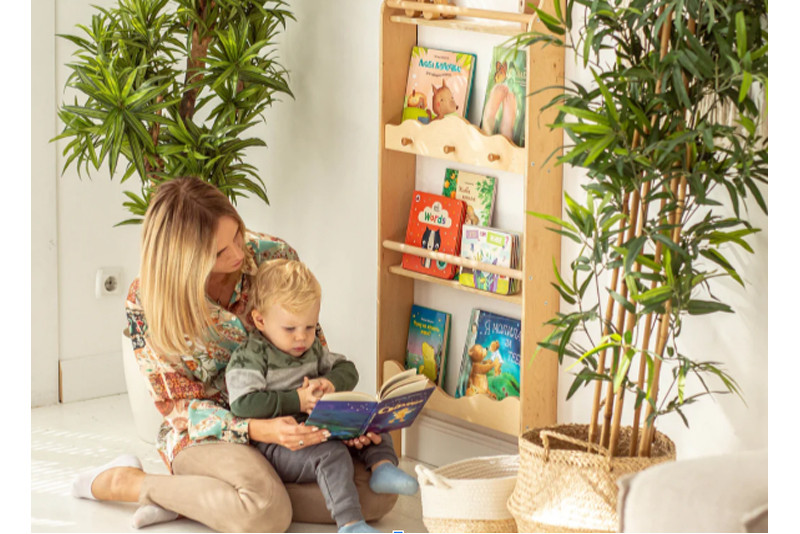The Montessori education philosophy, grounded in the principles set forth by Dr. Maria Montessori, emphasizes creating learning environments that foster children’s natural desire to learn. Central to this approach is the concept of the Montessori bookshelf, which is not just a piece of furniture but a carefully curated and organized tool designed to stimulate curiosity, independence, and a love for reading in early childhood.

This article explores the significance of strategic book placement to enhance engagement and learning, underlining the profound impact of a well-organized Developmental bookshelf on a child’s educational journey.
The Montessori Approach to Learning Environments
The foundation of Montessori education lies in creating meticulously organized environments that cater to the natural learning processes of children. These environments are characterized by a few key principles designed to foster self-directed learning and independence:
Structured Freedom: Montessori environments offer children the freedom to choose their activities within a structured framework. This balance encourages self-discipline and self-motivation, as children learn to navigate their choices within set boundaries.
Order and Accessibility: Every element, from furniture to learning materials, is arranged thoughtfully to promote order and ease of access.
This organization:
Ensures materials are placed at the child’s level, allowing easy access without adult assistance.
Maintains a clutter-free and orderly setting, which is crucial for helping children concentrate and feel secure.
Real-World Connections: The setup of Montessori spaces mirrors the real world, enabling children to make meaningful connections between their learning environment and their experiences. Practical life skills are a significant focus, with materials and activities designed to mimic everyday tasks.
Sensory-rich Materials: Developmental environments are rich in sensory experiences, providing materials that engage all five senses. This sensory engagement is vital for cognitive development and helps children refine their sensory perceptions and motor skills.
Individualized Learning Pace: Recognizing that each child develops at their own pace, Montessori environments are designed to accommodate individual learning journeys. Materials are sequenced from simple to complex, supporting the child’s natural progression of skills and understanding.
By adhering to these principles, Montessori environments create a nurturing space where children are empowered to explore, learn, and grow independently. The emphasis on order, accessibility, and connection to the real world ensures that children develop not only academically but also socially and emotionally, fully prepared to meet the challenges of the world around them.
Psychological Principles Behind Book Placement
Children’s cognitive development plays a crucial role in how they interact with reading materials. The arrangement of books on a Montessori shelf can significantly influence a child’s choice and interest. Visual accessibility is paramount; books placed at eye level for children are more likely to be picked up and explored. Furthermore, the Zone of Proximal Development (ZPD) theory supports the idea of organizing books in a way that slightly stretches a child’s current abilities, thereby promoting learning and development.
Pedagogical Strategies for Bookstand Organization
Effective Montessori bookshelves are organized based on themes, difficulty levels, and children’s interests, facilitating easier selection and exploration. Rotating books regularly keeps the selection fresh and encourages children to discover new interests. Moreover, the placement of books is crucial in fostering independence, with the arrangement allowing children to return books to their designated spots, promoting a sense of order and responsibility.
Practical Tips for Organizing Your Montessori Bookshelf
Organizing Early childhood pieces requires thoughtful consideration of the children’s developmental stages and interests to create an engaging and accessible reading environment. Here are key strategies to enhance the effectiveness and appeal of your Montessori bookshelf:
Select Books Wisely:
Focus on a diverse selection that caters to various interests, cultures, and levels of reading complexity. Ensure the collection includes books that reflect the children’s backgrounds and experiences, as well as those that introduce new perspectives and ideas.
Strategic Placement for Visibility and Access:
Position books so that their covers, rather than spines, face outward, making them more visually appealing and inviting to young readers.
Arrange books at the child’s eye level to encourage exploration and independence in selection.
Categorize Thoughtfully:
Organize books by theme, genre, or reading level to simplify the search process for children. Clear categorization helps children gravitate toward books that interest them and are appropriate for their reading skills.
Implement a Rotation System:
Regularly rotate books to keep the selection fresh and interesting. Highlight seasonal themes, cultural holidays, or topics of current interest to maintain engagement and curiosity.
Encourage Child Participation:
Involve children in the selection process by asking for their feedback on the books they enjoy or topics they’re curious about.
Allow children to assist in organizing the bookshelf, which fosters a sense of ownership and responsibility towards the reading environment.
Accessibility for All:
Ensure that children with different needs can easily access and enjoy the bookshelf. Consider accessibility adjustments for children with physical disabilities or sensory preferences.
Challenges and Solutions
Maintaining an organized Montessori bookshelf can present challenges, such as limited space or resources. Solutions include using vertical space wisely, opting for bookshelves that offer varying heights and depths for different book sizes, and being creative with the location of the bookcase to make it a focal point of the learning environment. Additionally, community resources like library sales or donations can help expand the book selection without significant expense.
Closing Thoughts
The science behind book placement on a Montessori bookshelf is a testament to the thoughtful integration of psychological and pedagogical principles in Early childhood education. A well-organized bookstand can significantly impact children’s engagement with reading, nurturing a lifelong love for learning. By applying these principles and strategies, educators and parents can create dynamic and inviting reading environments that cater to the diverse needs of young learners.
The key to promoting a robust culture of reading lies in the meticulous organization of the Montessori bookshelf, proving that when children are given the freedom to explore, their learning potential is boundless.
